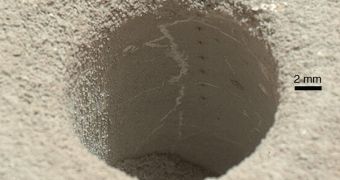Mission controllers at the NASA Jet Propulsion Laboratory (JPL), in Pasadena, California, say that the Mars Science Laboratory (MSL) rover Curiosity has already exceeded all expectations on the surface of the Red Planet, after having investigated our neighboring world for just a little over a year.
The robotic explorer has already provided scientists with a wealth of data on the age of certain rocks on the surface of the planet, and was able to uncover solid evidence that Mars was once capable of supporting microbial life. Additionally, radiation levels on the surface were measured for the first time.
These announcements were made at the Fall Meeting of the American Geophysical Union, which is currently being held in San Francisco. A total of six papers accompanied the talks. The studies were published in the December 9 online issue of the journal Science Express.
One of the most important studies conducted on Mars was carried out on Cumberland, which was the second-ever rock Curiosity drilled. Its age was estimated to be between 4.56 and 3.86 billion years, but the rover found that its upper layers have been exposed to the elements as early as 60 million to 100 million years ago.
This suggests that radiation and sand-laced winds on Mars are eroding and destroying exposed rock surfaces a lot faster than originally predicted. This study was also important because it gave scientists some insight into how organic molecules are preserved on the Red Planet from ancient environments.
“We're making progress on the path to determining whether there are Martian organics in there. We detect organics but can't rule out that they might be brought along from Earth,” announced scientist Doug Ming, from the NASA Johnson Space Center, in Houston, Texas.
Curiosity also made another important finding, this time at a site called Yellowknife Bay. A rock at that location, called John Klein, revealed what may very well be the first evidence that ancient Mars was indeed a favorable environment for microbial life billions of years ago.
“Our measurements provide crucial information for human missions to Mars,” explains researcher Don Hassler, who is based at the Southwest Research Institute (SwRI), in Boulder, Colo..
Using data from Curiosity, collected both on the Martian surface and on its way there, scientists have determined that future astronauts will be exposed to about 1,000 millisieverts of radiation over the course of a round-trip to Mars. Such a level is the equivalent of a 5 percent increase in risks for developing fatal cancer.

 14 DAY TRIAL //
14 DAY TRIAL //